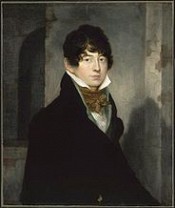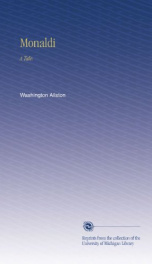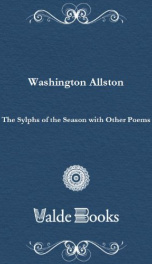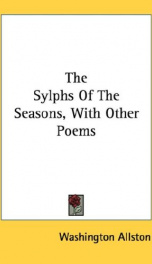Allston Washington

Washington Allston (November 5, 1779 – July 9, 1843) was an American poet and influential painter, born in Waccamaw Parish, South Carolina. Allston pioneered America's Romantic movement of landscape painting. He was well known during his lifetime for his experiments with dramatic subject matter and his bold use of light and atmospheric color. Allston was born on a rice plantation on the Waccamaw River near Georgetown, South Carolina. His mother Rachel Moore had married Captain William Allston in 1775, though her husband died in 1781, shortly after the Battle of Cowpens.[1] Moore remarried to Dr. Henry C. Flagg, the son of a wealthy shipping merchant from Newport, Rhode Island.[2] Named in honor of the leading American general of the Revolution[3], Washington Allston graduated from Harvard College in 1800 and moved to Charleston, South Carolina for a short time before sailing to England in May 1801.[2] He was admitted to the Royal Academy in London in September, when painter Benjamin West was then the president.[4] From 1803 to 1808 he visited the great museums of Paris and then for several years those of Italy, where he met Washington Irving in Rome,[5] and Coleridge, his lifelong friend. In 1809 Allston married Ann Channing, sister of William Ellery Channing.[2] Samuel F. B. Morse was one of Allston's art pupils and accompanied Allston to Europe in 1811. After traveling throughout western Europe, Allston finally settled in London, where he won fame and prizes for his pictures. Allston was also a published writer. In London in 1813, he published The Sylphs of the Seasons, with Other Poems, republished in Boston, Massachusetts later that year.[6] His wife died in February 1815, leaving him saddened, lonely, and homesick for America.[7] In 1818 he returned to the United States and lived in Cambridge, Massachusetts for 25 years. He was the uncle of the artists George Whiting Flagg and Jared Bradley Flagg, both of whom studied painting under him. In 1841 he published Monaldi, a romance illustrating Italian life, and in 1850, a volume of his Lectures on Art, and Poems.[8] Allston died on July 9, 1843, at age 64. Allston is buried in Harvard Square, in "the Old Burying Ground" between the First Parish Church and Christ Church. Allston was sometimes called the "American Titian" because his style resembled the great Venetian Renaissance artists in their display of dramatic color contrasts. His work greatly influenced the development of U.S. landscape painting. Also, the themes of many of his paintings were drawn from literature, especially Biblical stories.[9] His artistic genius was much admired by Samuel Taylor Coleridge, and Ralph Waldo Emerson was strongly influenced by his paintings and poems, but so were both Margaret Fuller and Sophia Peabody, wife of Nathaniel Hawthorne.[9] The influential critic and editor Rufus Wilmot Griswold dedicated his famous anthology The Poets and Poetry of America to Allston in 1842.[10] Poet Henry Wadsworth Longfellow, 17 years after Allston's death, wrote that: "One man may sweeten a whole time. I never pass through Cambridge Port without thinking of Allston. His memory is the quince in the drawer and perfumes the atmosphere."[2] Boston painter William Morris Hunt was an admirer of Allston's work, and in 1866 founded the Allston Club in Boston, and in his arts classes passed on to his students his knowledge of Allston's techniques.[11] Washington Allston coined the term "objective correlative," which T. S. Eliot described as a situation or a chain of events that acts as a formula and is used in art to evoke emotion. The west Boston, Massachusetts neighborhood of Allston is named after him. Coast Scene on the Mediterranean, 1811, Columbia Museum of Art, Columbia, South Carolina Moonlit Landscape, 1809, Museum of Fine Arts, Boston, Massachusetts Storm Rising at Sea, 1804, Museum of Fine Arts, Boston, Massachusetts
do you like this author?
What readers are saying
What do you think? Write your own comment on this book!
write a commentWhat readers are saying
What do you think? Write your own comment on this author!
write a commentBook list

monaldi a tale
Series:
Unknown
Year:
Unknown
Raiting:
4/5
This volume is produced from digital images created through the University of Michigan University Library's preservation reformatting program. The Library seeks to preserve the intellectual content of items in a manner that facilitates and promotes a variety of uses. The digital reformatting process results in an electronic version of the text that can both be accessed online and used to create new print copies. This book and thousands of others can be found in the digital collections of the University of Michigan Library. The University Library also understands and values the utility of print, and makes reprints available through its Scholarly Publishing Office.
Show more
add to favoritesadd In favorites
Book list

monaldi a tale
Series:
Unknown
Year:
Unknown
Raiting:
4/5
This volume is produced from digital images created through the University of Michigan University Library's preservation reformatting program. The Library seeks to preserve the intellectual content of items in a manner that facilitates and promotes a variety of uses. The digital reformatting process results in an electronic version of the text that can both be accessed online and used to create new print copies. This book and thousands of others can be found in the digital collections of the University of Michigan Library. The University Library also understands and values the utility of print, and makes reprints available through its Scholarly Publishing Office.
Show more
add to favoritesadd In favorites

The Sylphs of the Season with Other Poems
Series:
Unknown
Year:
Unknown
Raiting:
3.5/5
The Sylphs of the Season with Other Poems. please visit www.valdebooks.com for a full list of titles
Show more
add to favoritesadd In favorites
What readers are saying
What do you think? Write your own comment on this author!
write a commentif you like Allston Washington try:
readers also enjoyed
What readers are saying
What do you think? Write your own comment on this author!
write a commentGenre
if you like Allston Washington try:
readers also enjoyed
Do you want to read a book that interests you? It’s EASY!
Create an account and send a request for reading to other users on the Webpage of the book!



